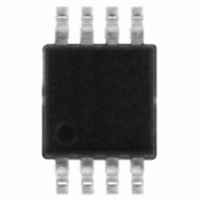TS4902IST STMicroelectronics, TS4902IST Datasheet - Page 17

TS4902IST
Manufacturer Part Number
TS4902IST
Description
IC AMP AUDIO PWR .7W MONO 8MSOP
Manufacturer
STMicroelectronics
Type
Class ABr
Datasheet
1.TS4902IST.pdf
(19 pages)
Specifications of TS4902IST
Output Type
1-Channel (Mono)
Max Output Power X Channels @ Load
700mW x 1 @ 8 Ohm
Voltage - Supply
2.2 V ~ 5.5 V
Features
Depop, Standby, Thermal Protection
Mounting Type
Surface Mount
Package / Case
8-MSOP, Micro8™, 8-uMAX, 8-uSOP,
Lead Free Status / RoHS Status
Lead free / RoHS Compliant
Other names
497-8116-2
TS4902IST
TS4902IST
Available stocks
Company
Part Number
Manufacturer
Quantity
Price
At power OFF of the supply, Cs is discharged by a
constant current Icc. The discharge time from 5V
to 0V of Cs is
Now, we must consider the discharge time of Cb.
At power OFF or standby ON, Cb is discharged by
a 100k
In the majority of application, Cb=1µF, then
We have finished a design and we have chosen
the components values :
• Rin=Rfeed=22k
Now, on fig. 13, we can see the PSRR (input
grounded) vs frequency curves. At 217Hz we have
a PSRR value of -36dB.
In fact, we want a value of about -70dB. So, we
need a gain of +34dB !
Now, on fig. 12 we can see the effect of Cb on the
PSRR (input grounded) vs. frequency. With
Cb=100µF, we can reach the -70dB value.
The process to obtain the final curve (Cb=100µF,
Cin=100nF, Rin=Rfeed=22k ) is a simple transfer
point by point on each frequency of the curve on
fig. 13 to the curve on fig. 12.
The measurement result is shown on figure A.
Fig. A : PSRR changes with Cb
b
b
Disch
Disch
-30
-40
-50
-60
-70
How to use the PSRR curves (page 7)
10
Cin=100nF
Cb=1 F
300ms >> t
3xCbx100k
resistor. So the discharge time is about
t
D i s ch C s
100
Cin=100nF
Cb=100 F
Frequency (Hz)
dischCs
Cin=100nF, Cb=1µF
=
Vcc = 5, 3.3 & 2.6V
Rfeed = 22k, Rin = 22k
Rg = 100 , RL = 8
Tamb = 25 C
1000
(s).
------------- - = 83 ms
5Cs
Icc
.
10000
100000
What is the PSRR ?
The PSRR is the Power Supply Rejection Ratio.
It's a kind of SVR in a determined frequency range.
The PSRR of a device is the ratio between the
power supply disturbance and the result on the
output. We can say that the PSRR is the ability of
a device to minimize the impact of power supply
disturbances to the output.
How do we measure the PSRR ?
Fig. B : PSRR measurement schematic
• Fix the DC voltage supply (Vcc)
• Fix the AC sinusoidal ripple voltage (Vripple)
• No bypass capacitor Cs is used
The PSRR value for each frequency is :
Remark : The measurement of the RMS voltage is
not a selective RMS measurement but a full range
(2 Hz to 125 kHz) RMS measurement. This means
we have: the effective RMS signal + the noise.
PSRR d B = 20 x Log
Remark on PSRR measurement conditions
Measurement process:
10
-------------------------------------------- -
Rms Vs
R ms V
r i p pl e
+
- Vs -
TS4902
17/19












